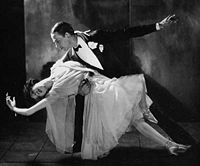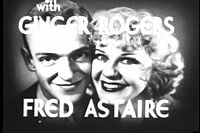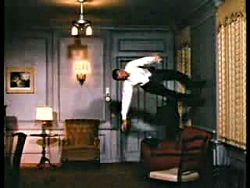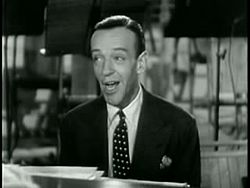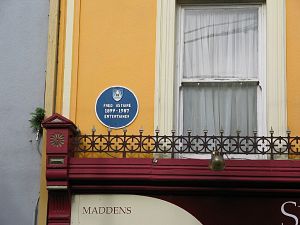Fred Astaire
| Fred Astaire | |
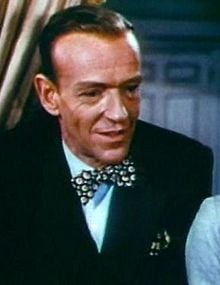 Fred Astaire in Royal Wedding (1951). | |
| Birth name: | Frederick Austerlitz Jr. |
|---|---|
| Date of birth: | May 10, 1899 |
| Birth location: | Omaha, Nebraska, USA |
| Date of death: | June 22 1987 (aged 88) |
| Death location: | Los Angeles, California, USA |
| Academy Awards: | Academy Honorary Award 1950 Lifetime Achievement |
| Spouse: | Phyllis Livingston Potter (1933-1954) Robyn Smith (1980-1987) |
Fred Astaire (May 10, 1899 – June 22, 1987), born Frederick Austerlitz in Omaha, Nebraska, was an American film and Broadway stage dancer, choreographer, singer and actor whose theater, film and, later, television career spanned a total of seventy-six years, during which he made thirty-one musical films. His legendary pairing with Ginger Rogers during the heydey of Hollywood musicals of the 1930s become an iconic symbol of style, grace, and charm that set a standard for dance that is still admired and emulated today. Their film Top Hat, Astaire's favorite and perhaps their most well known, along with films such as Swing Time and Shall We Dance revolutionized the musical genre and endeared them to Americans searching for idealism - and happy endings - after the Great Depression.
After dancing partnerships and musicals waned, Astaire went on to develop a highly respected career in films like The Towering Inferno(1975) and The Man in the Santa Claus Suit. His numerous television appearances including specials such as An Evening with Fred Astaire. He worked with some of the great composers and songwriters of the era like Irving Berlin, George Gershwin and Cole Porter. quote here.
Early life and career
His father was an Austrian immigrant and a Catholic; his mother was born in the U.S. to Lutheran German parents; Astaire became an Episcopalian in 1912.[1]
Astaire was a name taken by him and his sister Adele Astaire for their vaudeville act in 1905. Family legend attributes it to an uncle surnamed "L'Astaire".[2] Their vaudeville career continued, with mixed fortunes and some interruptions due to the actions of the Gerry Society, until they broke into Broadway with Over The Top in 1917.
During the 1920s, Fred and Adele appeared on Broadway and on the London stage in shows such as Lady Be Good, Funny Face and The Band Wagon, winning popular acclaim with the theater crowd on both sides of the Atlantic. As a team they made a few recordings. They split in 1932, when Adele married her first husband, Lord Charles Cavendish, a son of the Duke of Devonshire. Fred went on to achieve success on his own on Broadway and in London with Gay Divorce, while considering offers from Hollywood.
Fred and Ginger
On his return to RKO Pictures he took fifth billing alongside Ginger Rogers in the 1933 Dolores Del Rio vehicle Flying Down to Rio. Although Astaire was initially very reluctant to become part of another dancing team, he was persuaded by the obvious public appeal of the Astaire-Rogers pairing and he went on to make a total of ten musical films with Ginger Rogers.
That partnership, and the choreography of Astaire and Hermes Pan, helped make dancing an important element of the Hollywood film musical. The Astaire-Rogers series are among the top films of the 1930s. They include The Gay Divorcee (1934), Roberta (1935), Top Hat (1935), Follow the Fleet (1936), Swing Time (1936), Shall We Dance (1937), and Carefree (1938). Six out of the nine musicals he created became the biggest moneymakers for RKO; all of the films brought a certain prestige and artistry that all studios at the time were looking for.
Thus, Astaire easily received the benefits of a percentage of the film's profits, something extremely rare in actors' contracts at that time; and complete autonomy over how the dances would be presented, allowing him to revolutionize dance on film.
Astaire is credited with two important innovations in early film musicals. First, his insistence that the (almost stationary) camera film a dance routine in a single shot, if possible, while holding the dancers in full view at all times. Astaire famously quipped: "Either the camera will dance, or I will." Astaire maintained this policy from The Gay Divorcee (1934) onwards
Astaire's style of dance sequences thus contrasted with the Busby Berkeley musicals, which were known for dance sequences filled with extravagant aerial shots, quick takes, and zooms on certain areas of the body, such as the arms or legs. Second, Astaire was adamant that all song and dance routines be seamlessly integrated into the plotlines of the film. Instead of using dance as mere spectacle as Busby Berkeley did, Astaire used it to move the plot along. Typically, an Astaire picture would include a solo performance by Astaire - which he termed his "sock solo", a partnered comedy dance routine, and a partnered romantic dance routine.
The era of the Hollywood musicals
See also: Fred Astaire's Solo and Partnered Dances
Astaire was a virtuoso dancer, able to convey lighthearted adventuresomeness or deep emotion when called for. His technical control and sense of rhythm were astonishing; according to one anecdote, he was able, when called back to the studio to redo a dance number he had filmed several weeks earlier for a special effects number, to reproduce the routine with pinpoint accuracy, down to the last gesture. Astaire's execution of a dance routine was prized for its elegance, grace, originality and precision. He drew from a variety of influences, including tap and other African-American rhythms, classical dance and the elevated style of Vernon and Irene Castle, to create a uniquely recognisable dance style which greatly influenced the American Smooth style of ballroom dance, and set standards against which subsequent filmed dance musicals would be judged. He choreographed all his own routines, usually with the assistance of other choreographers, primarily Hermes Pan.
Extremely modest Astaire introduced some of the most celebrated songs from the Great American Songbook, in particular, Cole Porter's: "Night and Day" from Gay Divorce (1932); Irving Berlin's "Isn't it a Lovely Day", "Cheek to Cheek" and "Top Hat, White Tie and Tails" from Top Hat (1935), "Let's Face the Music and Dance" from Follow the Fleet (1936) and "Change Partners" from Carefree (1938). He first presented Jerome Kern's "The Way You Look Tonight" from Swing Time 1936); the Gershwins' "They Can't Take That Away From Me" from Shall We Dance (1937), "A Foggy Day" and "Nice Work if You Can Get it" from A Damsel in Distress (1937) and he introduced Johnny Mercer's "One for My Baby" from The Sky's the Limit (1943) and "Something's Gotta Give" from Daddy Long Legs (1955) along with Harry Warren and Arthur Freed's "This Heart of Mine" from Ziegfeld Follies (1946).
Astaire also co-introduced a number of song classics via song duets with his partners. For example, with his sister Adele, he co-introduced the Gershwins' "I'll Build a Stairway to Paradise" from Stop Flirting (1923), "Fascinating Rhythm" from Lady, Be Good (1924), "Funny Face" from Funny Face (1927); and, in duets with Ginger Rogers, he presented Irving Berlin's "I'm Putting All My Eggs In One Basket" from Follow the Fleet (1936), Jerome Kern's "Pick Yourself Up" and "A Fine Romance" from Swing Time (1936), along with The Gershwins' "Let's Call The Whole Thing Off" from Shall We Dance (1937). With Judy Garland he sang Irving Berlin's "A Couple of Swells" from Easter Parade (1948); and, with Jack Buchanan, Oscar Levant, and Nanette Fabray he delivered Betty Comden and Adolph Green's "That's Entertainment" from The Band Wagon (1953).
Although he possessed a light voice, he was admired for his lyricism, diction and phrasing[3] - the grace and elegance so prized in his dancing seemed to be reflected in his singing, a capacity for synthesis which led Burton Lane to describe him as "The world's greatest musical performer."[4] Irving Berlin considered Astaire the equal of any male interpreter of his songs - "as good as Jolson, Crosby or Sinatra, not necessarily because of his voice, but for his conception of projecting a song".[5] Jerome Kern considered him the supreme male interpreter of his songs[6] and Cole Porter and Johnny Mercer also admired his unique treatment of their work. And while George Gershwin was somewhat critical[7] of Astaire's singing abilities, he wrote many of his most memorable songs for him. In his heyday, Astaire was referenced[8] in lyrics of songwriters Cole Porter, Larry Hart and Eric Maschwitz and continues to inspire modern songwriters.[9]
Other teamings
In 1939, Astaire left RKO to freelance and pursue new film opportunities. He teamed up with other stars, notably with Bing Crosby in Holiday Inn (1942) and later Blue Skies (1946). He was almost outdanced in Broadway Melody of 1940 (1940) by one of his first post-Rogers dance partners, Eleanor Powell. Other partners during this period included Paulette Goddard in Second Chorus (1940), Rita Hayworth in You'll Never Get Rich (1941) and You Were Never Lovelier (1942), Joan Leslie in The Sky's the Limit (1943), and Lucille Bremer in Yolanda and the Thief (1945) and Ziegfeld Follies (1946). Ziegfeld Follies also contains a memorable teaming of Astaire with Gene Kelly.
After announcing his retirement with Blue Skies in 1946, Astaire concentrated on his horse-racing interests and went on to found the Fred Astaire Dance Studios in 1947 - which he subsequently sold in 1966. However, he soon returned to the big screen to replace the injured Gene Kelly in Easter Parade (1948) opposite Judy Garland and Ann Miller, and for a final reunion with Rogers, The Barkleys of Broadway (1949). He then went on to make more musicals throughout the 1950s: Let's Dance (1950) with Betty Hutton, Royal Wedding (1951) with Jane Powell, Three Little Words (1950) and The Belle of New York (1952) with Vera Ellen, The Band Wagon (1953) and Silk Stockings (1957) with Cyd Charisse, Daddy Long Legs (1955) with Leslie Caron, and Funny Face (1957) with Audrey Hepburn. His legacy at this point was thirty musical films in a twenty-five year period. Afterwards, Astaire announced that he was retiring from dancing in film to concentrate on dramatic acting, scoring rave reviews for the nuclear war drama On the Beach (1959).
Transition to televsion and movies
Astaire did not give up dancing completely. He made a series of four highly rated, Emmy-winning musical specials for television in 1958, 1959, 1960, and 1968, each featuring Barrie Chase. The first of these programs, 1958's An Evening with Fred Astaire, won nine Emmy Awards, including "Best Single Performance by an Actor" and "Most Outstanding Single Program of the Year." It was also noteworthy for being the first major broadcast to be prerecorded on color videotape.
Astaire's last major musical film was Finian's Rainbow (1968), in which he shed his white tie and tails to play an Irish rogue who believes if he buries a crock of gold in the shadows of Fort Knox it will multiply. His dance partner was Petula Clark, who portrayed his skeptical daughter. He admitted to being as nervous about singing with her as she confessed to being apprehensive about dancing with him.
Astaire continued to act into the 1970s, appearing in films such as The Towering Inferno (1974), for which he received his only Academy Award nomination in the category of Best Supporting Actor. He appeared in the first two That's Entertainment! documentaries in the mid-1970s. In the second, aged seventy-seven, he performed a number of song-and-dance routines with Gene Kelly — his last dance performances in a musical film. In 1976 he recorded a disco-styled rendition of Carly Simon's "Attitude Dancing." In 1978 Fred Astaire co-starred with Helen Hayes in a well-received television film, A Family Upside Down, in which they play an elderly couple coping with failing health. Astaire won an Emmy Award for his performance. He made a well-publicized guest appearance on the science fiction TV series Battlestar Galactica in 1979. His final film was the 1981 adaptation of Peter Straub's Ghost Story.
Marriages and family life
Fred was also inspired by Bill Robinson to do tap dancing as well [[1]]
Astaire married for the first time in 1933, to Phyllis Potter (née Phyllis Livingston Baker, 1908-1954), a Boston-born New York socialite and former wife of Eliphalet Nott Potter III (1906-1981). In addition to Phyllis's son, Eliphalet IV, known as Peter, the Astaires had two children, Fred Jr. (born 1936, he appeared with his father in the movie Midas Run but became a charter pilot and rancher instead of an actor), and Ava, Mrs. Richard McKenzie (born 1942) who remains actively involved in promoting her late father's heritage.
Described by his friend David Niven as "a pixie — timid, always warm-hearted, with a penchant for schoolboy jokes," Astaire was a lifelong golf and horse-racing enthusiast, whose horse Triplicate won the 1946 Hollywood Gold Cup. well into his eighties and remarried in 1980, to Robyn Smith, an actress turned champion jockey almost 45 years his junior.
Fred Astaire died in 1987 from pneumonia at the age of 88 and was interred in the Oakwood Memorial Park Cemetery in Chatsworth, California. One last request of his was to thank his fans for their years of support.
Legacy
Balanchineand Nureyevrated him the greatest dancer of the twentieth century, and he is generally acknowledged to have been the most influential dancer in the history of filmed and televised musicals. He was named the fifth Greatest Male Star of All Time by the American Film Institute.
His perfectionism was legendary as was his modesty and consideration towards his fellow artists; however, his relentless insistence on rehearsals and retakes was a burden to some. Although he viewed himself as an entertainer first and foremost, his consummate artistry won him the adulation of such twentieth century dance legends as George Balanchine, the Nicholas Brothers, Mikhail Baryshnikov, Margot Fonteyn, Bob Fosse, Gregory Hines, Gene Kelly, Rudolph Nureyev, and Bill Robinson.
Awards and honors
Fred Astaire, through his career has acrued the following awards and honors:[10]
- (1938) - Invited to place his hand and foot prints in cement at Grauman's Chinese Theatre, Hollywood.
- (1950) - Ginger Rogers presented an honorary Academy Award to Astaire "for his unique artistry and his contributions to the technique of musical pictures".
- (1950) - Golden Globe for "Best Motion Picture Actor -Music/Comedy" for Three Little Words.
- (1958) - Emmy Award for "Best Single Performance by an Actor" for An Evening with Fred Astaire.
- (1959) - Dance Magazine award.
- (1960) - Nominated for Emmy Award for "Program Achievement" for Another Evening with Fred Astaire.
- (1960) - Golden Globe Cecil B. DeMille Award for "Lifetime Achievement in Motion Pictures".
- (1961) - Emmy Award for "Program Achievement" in 1961 for Astaire Time.
- (1961) - Voted Champion of Champions - Best Television performer in annual television critics and columnists poll conducted by Television Today and Motion Picture Daily.
- (1965) - The George Award from the George Eastman House for "outstanding contributions to motion pictures".
- (1968) - Nominated for an Emmy Award for Musical Variety Program for The Fred Astaire Show.
- (1972) - Named Musical Comedy Star of the Century by Liberty Magazine.
- (1973) - Subject of a Gala by the Film Society of Lincoln Center.
- (1975) - Golden Globe for "Best Supporting Actor", BAFTA and David di Donatello awards for The Towering Inferno.
- (1978) - Emmy Award for "Best Actor - Drama or Comedy Special" for A Family Upside Down.
- (1978) - Honored by the Academy of Television Arts & Sciences.
- (1978) - First recipient of the Kennedy Center Honors.
- (1978) - National Artist Award from the American National Theatre Association for "contributing immeasurably to the American Theatre".
- (1981) - The Lifetime Achievement Award from the AFI.
- (1987) - The Capezio Dance Shoe Award (co-awarded with Rudolph Nureyev).
- (1989) - Posthumous award of Grammy Lifetime Achievement Award.
- (1991) - Posthumous induction into the Ballroom Dancer's Hall of Fame.
- (2000) - Ava Astaire McKenzie unveils a plaque in honour of her father, erected by the citizens of Lismore, County Waterford, Ireland.
Filmography
(*) w/ Ginger Rogers |
|
Television work
|
|
| Awards | ||
|---|---|---|
| Preceded by: John Gielgud for Murder on the Orient Express |
BAFTA Award for Best Actor in a Supporting Role 1976 for The Towering Inferno |
Succeeded by: Brad Dourif for One Flew Over the Cuckoo's Nest |
Notes
- ↑ Astaire p.84
- ↑ Thomas p.17
- ↑ Thomas p.118
- ↑ Mueller p.21
- ↑ Wikiquote, Fred Astaire
- ↑ Mueller p.21
- ↑ Mueller pp.123,128
- ↑ Wikiquote: Fred Astaire
- ↑ e.g. the songs "I Am Fred Astaire" by Taking Back Sunday, "No Myth" by Michael Penn, "Take you on a cruise" by Interpol, "Fred Astaire" by Lucky Boys Confusion, "Long Tall Glasses" by Leo Sayer, "Just Like Fred Astaire" by James, "After Hours" by "The Bluetones", "Fred Astaire" by Pips, Chips and Videoclips, "Decadence Dance" by Extreme, and appeared on the cover of The Beatles, Sgt. Pepper's Lonely Hearts Club Band album
- ↑ Billman, pp.287-290
ReferencesISBN links support NWE through referral fees
- Astaire, Fred Steps in Time, 1959, multiple reprints.
- Carrick, Peter. 1984. A Tribute to Fred Astaire, Salem House, ISBN 0881620815
- Thomas, Bob 1985.Astaire, the Man, The Dancer. Weidenfeld & Nicolson, London, ISBN 0-297-78402-1
Further Reading
- Billman, Larry. 1997. Fred Astaire - A Bio-bibliography, Greenwood Press, ISBN 0-313-29010-5
- Boyer, 2005. Fred Astaire Style, Assouline, ISBN 2-84323-677-0
- Croce, Arlene. 1974. The Fred Astaire and Ginger Rogers Book, Galahad Books, ISBN 0-88365-099-1
- Crouse, Jeffrey. 2003."Letting His Wish Provide the Occasion: Fred Astaire in Top Hat", Film International, No. 5.
- Freeland, Michael. 1976. Fred Astaire An Illustrated Biography, Grosset & Dunlap, ISBN 0-448-14080-2
- Gallafent, Edward. 2002. Astaire and Rogers, Columbia University Press, ISBN 0231 126263
- Giles, Sarah. 1988. Fred Astaire - His Friends Talk, Bloomsbury, London, ISBN 0-7475-0322-2
- Green, Benny 1980. Fred Astaire, Bookthrift Co. ISBN 0896730182
- Green, Stanley and Burt Goldblatt. 1973. Starring Fred Astaire, Dodd ISBN 0-396-06877-4
- Hyam, Hannah. 2007. Fred and Ginger - The Astaire-Rogers Partnership 1934-1938, Pen Press Publications, Brighton, ISBN 978-1-905621-96-5
- Lamparski, Richard. 2006. Manhattan Diary. BearManor Media ISBN 1-59393-054-2
- Mueller, John. 1985.Astaire Dancing - The Musical Films of Fred Astaire, Knopf, ISBN 0-394-51654-0
- Satchell, Tim. 1987.Astaire, The Biography. Hutchinson, London. ISBN 0-09-173736-2
- The Astaire Family Papers, The Howard Gotleib Archival Research Center, Boston University, MA, U.S.A.
External links
- Fred Astaire at the Internet Movie Database (Astaire is the first biographical entry in the IMDB database.)
- Fred Astaire at the TCM Movie Database
- Fred Astaire at the Internet Broadway Database
- Fred Astaire biography at Allmovie Guide
- Fred Astaire tribute site.
- Fred Astaire biography at AlsoDances.Net
- Time.com: The Great American Flyer Fred Astaire:1899-1987
- Time Magazine archive: Astaire essay by Richard Corliss
- Astaire's religious views incl. many extracts from his biographers
- Ava Astaire discusses her father's legacy. (BBC Television - Realplayer required)
- http://www.findagrave.com/cgi-bin/fg.cgi?page=gr&GRid=1624 Fred Astaire] at Find-A-Grave
- "He's in Heaven..." - In Memoriam Fred Astaire
| Preceded by: Paul Douglas 22nd Academy Awards |
Oscars host 23rd Academy Awards |
Succeeded by: Danny Kaye 24th Academy Awards |
| Songwriters |
|
Arlen | Berlin | Blane | Cahn | Carmichael | Coleman | Dietz | Ellington | Fain | Fields | G. Gershwin | I. Gershwin | Hammerstein | Hart | Kern | Lerner | Loewe | Loesser | Mancini | Mandel | Martin | Mercer | McHugh | Porter | Rodgers | Schwartz | Styne | Webster |
| Singers |
|
Anka | Armstrong | Astaire | Bennett | Boswell | Boswells | Brice | Bublé | Carter | Clooney | Cole | Como | Connick | Crosby | Day | Dearie | Eckstine | Faye | Feinstein | Fitzgerald | Francis | Garland | Holiday | Horn | Horne | Keel | Kelly | Krall | Laine | Lamour | Lee | Manilow | Martin | Mathis | McRae | Midler | Nilsson | Page | Rogers | Shore | Simone | Sinatra | Stafford | Stewart | Streisand | Tormé | Vaughan | Washington | Williams |
| Persondata | |
|---|---|
| NAME | Astaire, Fred |
| ALTERNATIVE NAMES | Austerlitz, Frederick (birth name) |
| SHORT DESCRIPTION | dancer and actor |
| DATE OF BIRTH | May 10, 1899 |
| PLACE OF BIRTH | Omaha, Nebraska, U.S. |
| DATE OF DEATH | June 22, 1987 |
| PLACE OF DEATH | Los Angeles, California, U.S. |
Credits
New World Encyclopedia writers and editors rewrote and completed the Wikipedia article in accordance with New World Encyclopedia standards. This article abides by terms of the Creative Commons CC-by-sa 3.0 License (CC-by-sa), which may be used and disseminated with proper attribution. Credit is due under the terms of this license that can reference both the New World Encyclopedia contributors and the selfless volunteer contributors of the Wikimedia Foundation. To cite this article click here for a list of acceptable citing formats.The history of earlier contributions by wikipedians is accessible to researchers here:
The history of this article since it was imported to New World Encyclopedia:
Note: Some restrictions may apply to use of individual images which are separately licensed.
